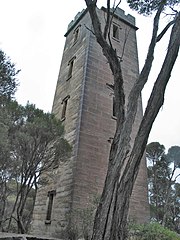Ben Boyd National Park
|
Ben Boyd National Park New South Wales |
|
|---|---|
|
IUCN category II (national park)
|
|

Ben Boyd's tower
|
|
| Coordinates | 37°10′43″S 149°58′56″E / 37.17861°S 149.98222°ECoordinates: 37°10′43″S 149°58′56″E / 37.17861°S 149.98222°E |
| Established | 1971 |
| Area | 104.86 km2 (40.5 sq mi) |
| Managing authorities | National Parks and Wildlife Service (New South Wales) |
| Website | Ben Boyd National Park |
| See also | Protected areas of New South Wales |
Ben Boyd National Park is a national park in New South Wales, Australia, 383 km (238 mi) south of Sydney.
The park is named after the entrepreneur Ben Boyd who had a variety of interests in the far South Coast of New South Wales including whaling and farming. The park itself was established in 1971. Originally 8,900 hectares in size, it has been expanded to 10,486 hectares.
Boyd commissioned the construction of a sandstone tower overlooking the entrance to the harbour of Twofold Bay to alert whaling crews of the approach of their prey. The tower was never completed.
The park consists of two sections, on either side of Twofold Bay and the town of Eden. The smaller northern section is bounded on its western border by the Princes Highway. The geology of this section is mainly sedimentary rock (ironstone and clay) laid down in the Paleogene, with some quartzite outcrops. The main attraction for tourists is the Pinnacles, a multicoloured erosion gully with white sands overlaying rusty red clay. The southern section coastline is metamorphic and Devonian in age, with some heavily folded sections at Red Point, near Boyd's tower.
The park is fairly flat, with none of the northern section exceeding 100 metres in elevation, and the southern section not much higher; the tallest peak is Haycock Hill at 252 metres. The region is particularly windy, dry and cold, and the headlands are covered in a low ground-hugging heathland community of plants. Further inland, the heath is replaced by open eucalypt woodland, which makes up most of the park's habitat. The two dominant tree species are silvertop ash (Eucalyptus sieberi) and red bloodwood (Corymbia gummifera). There are also scattered pockets of rainforest in gullies and protected areas, with species such as the scentless rosewood (Synoum glandulosum) and smooth mock-olive (Notelaea venosa).
...
Wikipedia

